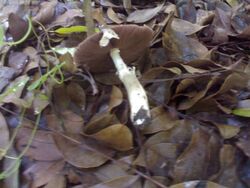Biology:Termitomyces eurhizus
| Termitomyces eurhizus | |
|---|---|

| |
| Scientific classification | |
| Domain: | Eukaryota |
| Kingdom: | Fungi |
| Division: | Basidiomycota |
| Class: | Agaricomycetes |
| Order: | Agaricales |
| Family: | Lyophyllaceae |
| Genus: | Termitomyces |
| Species: | T. eurhizus
|
| Binomial name | |
| Termitomyces eurhizus (Berk.) R.Heim (1942)
| |
| Synonyms | |
| |
Termitomyces eurhizus species of agaric fungus in the family Lyophyllaceae native to Pakistan, India, Sri Lanka, Burma, southwestern China and Malaysia. The fungus has a symbiotic relationship with termites, its mushrooms growing out of mounds after periods of rainfall. It is eaten in Malaysia and the Indian subcontinent.
Taxonomy
Miles Joseph Berkeley named the fungus in 1847 as Agaricus eurhizus, from material collected in Peradeniya in Sri Lanka.[1] French botanist Roger Heim reclassified the species as Termitomyces eurhizus in 1942.[2] Its place in Termitomyces was confirmed with a 2000 ribosomal DNA study showing that the termite mushrooms form a clade.[3]
Description
The cap is from 6–15 cm across, with rare specimens up to 24 cm in diameter. Grey-brown and fading to whitish at the margins, the cap is initially convex before expanding out with a central boss.[4] The crowded white gills are free to subadnate. The ringless stout white stem is up to 20 cm high and 1.5 to 2.5 cm across. It continues into the soil. The spore print is pink, and the oval spores are 6.8–9.3 μm long by 5.1–6.8 μm wide.[5]
Distribution, habitat and ecology
Widely distributed, T. eurhizus has been recorded from Pakistan, India, Sri Lanka, Burma, southwestern China and Malaysia. Like other members of the genus, the mushrooms grow out of termite mounds.[4] T. eurhizus is associated with the termite species Macrotermes gilvus in Selangor, Malaysia, and Odontotermes badius in Sri Lanka.[4] The fungus and the termites have a complex symbiotic relationship.[3] The termites cultivate the fungus on plant material within the mound, which they eat. The nutrients in their food are made more digestible by the fungus. After rain, the fungus is triggered into producing large mushrooms that grow and spread spores elsewhere.[3]
Consumption
In October 1972, it was recorded as being sold in markets in Midnapore in West Bengal.[5] In the northern Malaysian state of Kedah, it is eaten by locals and known as cendawan kaki lembu "cattle leg mushroom".[4]
References
- ↑ "Decades of fungi, xv–xix. Ceylon Fungi". Hooker's London Journal of Botany 6: [482]. 1847. https://biodiversitylibrary.org/page/2926497.
- ↑ Heim R. (1942). "Nouvelles études descriptives sur les agarics termitophiles d'Afrique tropicale" (in French). Archives du Muséum National d'Histoire Naturelle 18 (6): 107–66. NAID 10008567368. OCLC 601361431.
- ↑ 3.0 3.1 3.2 "Phylogenetic relationships of Termitomyces and related taxa". Mycological Research 107 (11): 1277–86. 2003. doi:10.1017/S0953756203008670. http://pdfs.semanticscholar.org/2547/8865bc6f26b77b8163dff0d6f51023dcdc7b.pdf.
- ↑ 4.0 4.1 4.2 4.3 "Termitomyces of Southeast Asia". Kew Bulletin 49 (4): 717–36. 1994.
- ↑ 5.0 5.1 "Termitomyces eurhizus, a new Indian edible mushroom". Transactions of the British Mycological Society 64 (1): 168–70. 1975. doi:10.1016/S0007-1536(75)80093-3.
Wikidata ☰ Q10693379 entry

